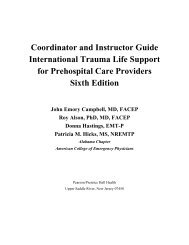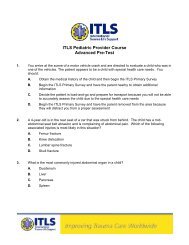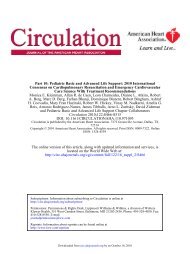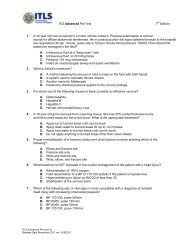ITLS Basic Pre-Test 7th Edition Page 1 - Wizard Education
ITLS Basic Pre-Test 7th Edition Page 1 - Wizard Education
ITLS Basic Pre-Test 7th Edition Page 1 - Wizard Education
Create successful ePaper yourself
Turn your PDF publications into a flip-book with our unique Google optimized e-Paper software.
<strong>ITLS</strong> <strong>Basic</strong> <strong>Pre</strong>-<strong>Test</strong> 7 th <strong>Edition</strong><br />
17 . Which of the following is most typical of early, neurogenic shock?<br />
A. Increased pulse, clammy skin<br />
B. Increased pulse, warm and dry skin<br />
C. Decreased pulse, clammy skin<br />
D. Decreased pulse, warm and dry skin<br />
18 . A 23 year old man is injured in a motorcycle collision. The patient appears disoriented and<br />
grossly intoxicated. There is a large laceration on his scalp which is actively bleeding. The<br />
patient refuses treatment and threatens to call his lawyer if anyone touches him. What<br />
should you do?<br />
A.<br />
B.<br />
Allow the patient to phone his lawyer<br />
Have the patient sign a release form, then let him go<br />
C. Have the patient placed under protective custody then treat and transport the<br />
patient using restraints if necessary<br />
D. Wait until the patient passes out from his head injury or bleeding then transport<br />
19 . A 54 year old man is involved in a motor vehicle collision. The steering wheel is bent. During<br />
your initial assessment you note his skin is pale and his radial pulses are present. Breath<br />
sounds are clear, heart tones are not muffled. Which one of the following is most consistent<br />
with these?<br />
A. Cardiac contusion<br />
B. Traumatic aortic rupture<br />
C. Flail chest<br />
D. Tension pneumothorax<br />
20 . What is the most common cause of cardiopulmonary arrest in the trauma patient?<br />
A. Brain injury<br />
B. Hypoxemia<br />
C. Myocardial contusion<br />
D. Ventricular arrhythmia<br />
21 . A 45 year old woman is found unconscious at the scene of a motor vehicle collision. Her<br />
vital signs are blood pressure, 80/40; pulse, 130/min; and respirations, 30/min. Which of the<br />
following is the MOST likely cause for her vital signs?<br />
A. Fractured lower legs<br />
B. Intra cranial hemorrhage<br />
C. Bleeding into the chest or abdomen<br />
D. Spinal cord injury with neurogenic shock<br />
22 . Which of the following regarding flow restricted oxygen-powered demand valves is TRUE?<br />
A. Allows for a good estimate of lung compliance<br />
B. Easy to determine the amount of volume delivered<br />
C. Gastric distension is not likely to occur<br />
D. Use of them is controversial and they may not be recommended for use<br />
23 . You respond to an adult patient who has a respiratory rate of 36 per minute, end tidal carbon<br />
dioxide level of 30 mmHg and an oxygen saturation of 80%. You should administer<br />
oxygen via:<br />
A. Non-rebreather mask at 12 liters per minute<br />
B. Nasal cannula at 6 liters per minute<br />
C. Venturi mask at 40%<br />
D. Bag-valve-mask ventilation with supplemental oxygen<br />
<strong>Page</strong> 3







